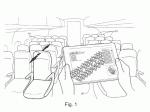B/E Aerospace
As airlines squeeze more and more seats onboard every plane, room — especially leg room— is a commodity worth its weight in gold.
Recently, the US Patent and Trademark Office published a patent application from B/E Aerospace's Travis Finlay, Glenn Johnson, and Pierre Vignal for a system of airplane seats that are adjustable based on the height of a passenger.
That's right, they've designed rows of seats on an airliner that can slide back and forth at the touch of button.
The system works like this. First, the airline would measure each passenger's height. Then, individuals would be grouped together based on their measurements. Passengers of a similar height would then be seated in the same row. Airline staff would then adjust each row accordingly using a digital handheld device.
That sounds simple enough.
Adjusting each row to correspond with the size of its passengers certainly seems reasonable in theory. However, it could prove to be complete and utter chaos in practice for several reasons.
First, waiting in line at the airport is already an exercise in impromptu meditation: remains calm, remain clam. Since seating assignments are done based on height, passengers would need to be measured at check-in. This adds an extra step and could cause delays in a process that is time consuming.
In addition, families would have to be split up among several rows of seats due to their height differences, unless an airline decides to seat them together in rows based on the height of the tallest person in the group.
On top of that, flight attendants would have to go through the tedious process of adjusting the legroom in each row prior to each flight. In an era when flight crews could have as little as 25 minutes to prepare a plane for a flight, this could prove to be economically unfeasible.
Ultimately, the biggest problem with the system could be from unhappy passengers. Space on board a plane is precious — especially in coach. If you thought people reclining their seats was controversial, just imagine the insanity that would ensue if passengers had chunks of legroom taken away and given to others.
According to the patent application, here's why B/E Aerospace decided to undertake this design. "The present invention relates to a method and apparatus for adjusting the spacing of seats based on the size of the passengers occupying the seats, particularly aircraft passengers, " the inventors wrote.
"While passengers come in many sizes — children, adolescents, adults, men, women and with large height differentials within these categories, seat spacing in the main cabin of passenger aircraft is generally uniform except at exit rows. This 'one size fits all' seating arrangement can cause discomfort for tall passengers, while a child or relatively small adult may be seated in an identical seat at the same pitch with more than ample leg room and in relative comfort."
B/E Aerospace, a publicly traded maker of airplane interiors, submitted the application to the USPTO last year and are awaiting approval.
Even if the patent is granted, there's no guarantee that B/E will actually build the seat, or that there will be any airline clients even interested in the concept. With that said, the adjustable seating system is intuitive and very logical — taller people should have more legroom!
But translating it into a workable realty could be a a challenge.
NOW WATCH: People doing backflips on a two-inch wide strap is a real sport called slacklining
See Also:
- China has knocked off a Range Rover and is selling it at a third of the price of the real thing
- Alfa Romeo's new sports sedan could be a threat to BMW
- The 15 most expensive cars for sale at Floyd Mayweather's favorite luxury dealership
SEE ALSO: Airbus just patented a jet that could fly from London to New York in 1 hour
